THINGLINK
Monday, 26 December 2016
Task 1 evidence audit
Work on Shot-lists, layouts, drafting, scripting or story boarding
In the blog post 'storyboard of our opening' it shows us an overview of the story line however comes across as quite confusing due to mis-communication of ideas therefore with the storyboard i created text to go with it to explain the overall objective. However as this doesn't identify exacts camera shots and layout of frames like we wanted it to portray i created a snother storyboard that is more of a representative of the opening which is very similar to the rough cut.
Friday, 16 December 2016
VILLIAN AND PROTAGANIST
An antagonist is a character, group of characters, institution, or concept that stands in or represents opposition against which the protagonist(s) must contend. In other words, an antagonist is a person or a group of people who opposes a protagonist.[1]- WIKIPEDIA DEFINITION


In our sequence the antagonist will be played by Sophie.We will be able to clearly identify her by
her costume. As you can see above the colour black has connotations of both power and mystery
which we aim to communicate through our the use of costume.The fact the character sophie is
playing dresses in all black tells us that she is not only powerful but is yet to bring and cause trouble
In Thrillers the antagonist is commonly seen wearing full black attire for example in the move ' An Inspector calls"
the inspectors costume is fully black( example below).This is one of the conventions of thrillers
and for this exact reason we are using this idea. Although the antagonist in our film is not physically causing
harm he 'is' mentally and we see the effect of this on the female character thought our sequence.
Thursday, 15 December 2016
Filming the mirror scene
THIS WAS OUR FINAL SHOT DUE TO THE FACT THAT WE WAS IN UNCERTAINTY WHETHER WE WANTED TO PUT A MASK ON THE MYSTERIOUS MAN, THIS WAS AN INITIAL IDEA THAT THE GROUP HAD WANTED FROM THE START OF PLANNING. HOWEVER FROM FEEDBACK WE GATHERED THAT THE MASK WOULD HAVE LOOKED AMATEUR AND CREATED AN OPPOSITE EFFECT TO THE THRILLING EFFECT WE WANTED TO PORTRAY. FOR THIS SHOT IT WAS A DIFFICULT ONE TO FILM AS THE SPACE WAS LIMITED AND WE NEEDED TO FILM IT FROM THE MIRROR PERSPECTIVE WITHOUT GETTING THE CAMERA IN. THIS SHOT WAS FILMED BY KAEJA AND IT WAS EXTREMELY HARD NOT TO BE WOBBLY AS THE TRIPOD HAD TO BE HELD IN THE END AS THE 3 LEGS WERE TO WIDE TO FIT IN THE LOCATION, THE CAMERA ALSO HAD TO BE AT A SLIGHT ANGLE SO IT WASN'T SHOWN IN THE MIRROR. A LOT OF DIRECTING AND OPINIONS WENT INTO THIS SCENE AS IT WAS HARD TO ACHIEVE A THREATENING ELEMENT AS SOPHIE IS THE SAME HEIGHT AT KIRSTY SO IT DIDN'T MAKE KIRSTY SEEM LIKE A VICTIM OR VULNERABLE JUST FROM THIS SHOT ALONE, SO WE HAD TO CONSIDER POSITIONING. SOPHIE ENDED UP STANDING IN THE BATH TUB AND ON HER TIPPY TOES TO MAKE HERSELF SEEM LARGER THAN SHE WAS.
IN THIS SHOT WE EXPERIMENTED WITH DIFFERENT WAYS TO MAKE IT MOST EFFECTIVE. AS WELL AS HAVING FUN WE DID STILL GET THE JOB DONE. KAEJA IS DIRECTING AND FILMING IN THE VIDEO AND SOPHIE IS POSITIONING HERSELF AND HELPING KAEJA WORK OUT THE CAMERA ANGLE.
IN THIS SHOT KAEJA TRIED AT FILMING FROM A DIFFERENT PERSPECTIVE BY TILTING THE CAMERA WHICH CREATED A NICE FFECT BUT IT DIDN'T FIT IN AS WELL WITH THE SCENE THEREFORE WE DIDN'T USE THIS MOVEMENT AND POSITIONING. BUT IT WAS GOOD TO TRY OUT DIFFERENT IDEAS AND SHOTS BEAUSE IT HELPED US FIGURE OUT WHAT WORKED FOR US BEST.
Proof of filming
RE-FILMING DAY
BASED ON THE FEEDBACK WE WERE GIVEN AS A RESULT OF OUR FIRST ROUGH EDIT, WE HAD TO RESHOOT A COUPLE OF CLIPS. OUR FEEDBACK INCLUDED NOT GOOD FRAMING IN ONE OF THE SCENES DUE TO THE DIFFICULT ANGLE WE WERE FILMING FROM. THE FIRST TIME WE FILMED WAS A CLOSE UP FROM ABOVE; THIS WAS A STRUGGLE TO FILM SEAMLESSLY AS SOPHIE HAD TO STAND ON THE BED AND THEREFORE COULD NOT USE A TRIPOD, RESULTING IN SHAKEY FOOTAGE. OUR FEEDBACK WAS TO RESHOOT THIS FROM A DIFFERENT ANGLE WHICH WE CARRIED OUT. HERE IS A SHORT VLOG OF THE DAY:
YOU CAN SEE KIRSTY LYING IN THE BED, SOPHIE POSITIONING THE CAMERA, AND KAEJA IS OUT OF THE SHOT DIRECTING THE SCENE. WE ARE VERY HAPPY WITH THE OUTCOME OF THESE NEW CLIPS AND WERE PLEASED THAT WE WERE GIVEN GOOD CRITICAL FEEDBACK THAT WE COULD IMPROVE ON.
PROOF OF EDITING
Some problems we noticed whilst editing our first sequence included inconsistency over two frames we filmed. In this first film still you can see our protagonist hits the alarm clock out of the way - however in the second film still you can see the alarm clock is still in the frame as if untouched. As consistency is crucial to our film we decided to reshoot this in order to make our film seamless.Rough cut feedback and Reflection

Based on our feedback given by our audience - there are some things we need to take into account for our final opening sequence.
Tuesday, 13 December 2016
RIGHTS ON FILMING IN PUBLIC
Photography advice
DUE TO OUR FILMING DATE I DID SOME RESEARCH IN TO OUR LEGAL RIGHTS TO FILM IN PUBLIC JUST TO PREVENT ANYTHING FROM STOPPING US FILMING ON THE DAY. I UNDERSTAND FROM THIS THAT I CANT FILM OTHER MEMBERS OF THE PUBLIC WITHOUT CONSENT. BELOW IS A COPY OF OUR RIGHTS TO FILM.
Photography advice
We encourage officers and the public to be vigilant against terrorism but recognise the importance not only of protecting the public from terrorism but also promoting the freedom of the public and the media to take and publish photographs.
Guidance around the issue has been made clear to officers and PCSOs through briefings and internal communications. The following advice is available to all officers and provides a summary of the Metropolitan Police Service’s guidance around photography in public places.
Freedom to photograph and film
Members of the public and the media do not need a permit to film or photograph in public places and police have no power to stop them filming or photographing incidents or police personnel.
Members of the public and the media do not need a permit to film or photograph in public places and police have no power to stop them filming or photographing incidents or police personnel.
Terrorism Act 2000
Photography and Section 44 of the Terrorism Act 2000
The power to stop and search someone under Section 44 of the Terrorism Act 2000 no longer exists.
Photography and Section 44 of the Terrorism Act 2000
The power to stop and search someone under Section 44 of the Terrorism Act 2000 no longer exists.
Police officers continue to have the power to stop and search anyone who they reasonably suspect to be a terrorist under Section 43 of the Terrorism Act.
Photography and Section 43 of the Terrorism Act 2000
Officers have the power to stop and search a person who they reasonably suspect to be a terrorist. The purpose of the stop and search is to discover whether that person has in their possession anything which may constitute evidence that they are a terrorist.
Officers have the power to stop and search a person who they reasonably suspect to be a terrorist. The purpose of the stop and search is to discover whether that person has in their possession anything which may constitute evidence that they are a terrorist.
Officers have the power to view digital images contained in mobile telephones or cameras carried by a person searched under S43 of the Terrorism Act 2000 to discover whether the images constitute evidence that the person is involved in terrorism. Officers also have the power to seize and retain any article found during the search which the officer reasonably suspects may constitute evidence that the person is a terrorist. This includes any mobile telephone or camera containing such evidence.
Officers do not have the power to delete digital images or destroy film at any point during a search. Deletion or destruction may only take place following seizure if there is a lawful power (such as a court order) that permits such deletion or destruction.
Monday, 5 December 2016
FINAL EDITING PICTURES

This is a image of me and my group completing further research for our opening sequence 'unbalanced'. Here we are all looking for specific things to improve our camera work.
FIRST EDITING SESSION
Here you can see a camtasia of our first editing session. We started by inserting the SD card and transferring all the clips we'd taken over the past couple of days onto our video drive - this was to prevent any missing clips as we'd saved them in multiple places. We then opened up Premiere Pro, a software which none of us were familiar with, as they have a range of tools we can use in order to create our final product. We played each file in order to make sure they were the correct ones and dragged them into the 'bin' in premiere. In this screen recording you can see us placing each clip into the sequence in chronological order of how we wanted it to be played. We cropped each clip to our desired length in order to create our very first rough edit. This editing session went well as it was our first time (except from the prelim) using premiere, and we used the basics effectively. The skills we learnt from this include how to import files from the video drive, crop the clips, and render the clips - giving us the foundations we needed for the upcoming editing sessions.
Pictures for evidence of filming
This picture of Kirsty shows one of our locations for her walking scene and Sophie is in the background behind the bushes for the shot we wanted to create. In this shot Kaeja filmed and over the shoulder of Sophie staring at Kirsty from behind the bushes and the film was focused on the figure of the man.
In this picture Sophie is dressed in her mysterious man outfit but her face will remain hidden throughout the future scenes. This is the location where she makes another encounter with this man and continues to be confused and feel scared by this moment. We purposely used this location and setting because it is filled with abandoned shops and is generally quite isolated which helped us portray our protagonists fear and helplessness.
This is the picture that is used when Kirsty receives the picture message of herself when she believes she is home alone in the bathroom. This is also the ending location for the film and the moment of suspense.

This picture shows Sophie prepping the camera for the alley way shot of Kirsty walking down, because the ally was a hill and Kirsty was walking down it we didn't want her to come across threatening a powerful so the camera was adjusted so it looked more of a normal height eye level to Kirsty.
In this image of Naomi she was also prepping the camera further down the alley so we could continue Kirsty's walk as she continues her journey for this shot Naomi went on the other side of the bar to get a different angle and a close up of Kirsty's face.
Saturday, 3 December 2016
Monday, 28 November 2016
FURTHER RESEARCH BASED ON FEEDBACK
Based on the feedback given to us after our pitch, i decided to do further research into some areas we were questioned about. For example, we were asked about the symptoms and side effects of being diagnosed with schizophrenia as this disorder plays a significant part in our film. I thought it would be appropriate to do some further research into this illness to ensure we do not offended anyone and we get our facts right. I visited rethink.org to find out more about the symptoms involved when struggling with this mental illness, and how we could accurately convey this within our opening sequence.
For example, i discovered that negative symptoms that may occur includes a lack of motivation, less interest in socialising, and a change in sleep patterns. We will aim to depict some of these symptoms in order to achieve a more realistic account of what it may be like to live with this disorder. As many people can suffer with a change in sleep patters, when we show the close up of the alarm clock - we will show our protagonist awakening at an unusual time, to give an insight into her illness. We will try to show the lack of motivation through our protagonists bedroom and attire. The bedroom we are using includes a mattress on the floor, with very minimal decoration - which is not really what you would expect from an average teenager. The costume she will be wearing will include jeans, a hoodie, and trainers - this will prove she is not worried about impressing anyone as she has less of an interest in socialising than possibly an average teen would.
As it is very common for people who suffer with schizophrenia to differentiate between the reality and non-reality, this is something we really want to shown within the opening scene. We will attempt this when editing by slowing down some clips and speeding up others to make it seem like we're inside the protagonists head.
DAY 1
DAY 1 OF FILMING
Before Filming we discussed which scenes we would aimed to complete on the following day. As a group we decided to begin filming the very first opening shots which included our main character ( Kirsty characters). Day one was very hectic for us as we had to mange both our feelings of excitement and our nerves in order to insure our first scenes were completed. Sophie filmed the very first scenes which included the close up of the clock and the main characters belongings. We experimented with a range of camera angles to ensure the shots looked visually exciting .
After doing this we had to shoot the close ups of our main character sleeping, again Sophie filmed this shot making sure we had a perfect angle. It was exactly this scene we had difficulty with as we wanted a close up of our characters face but due to filming on a extremely the tri-pods feet where at uneven heights causing the camera to wobble and produce unstable moving images. We had to ensure Sophie kept extremely still when filming because of this.
Below we have our main characters outfit she is wearing pyjamas as she has just finished her sleeping scene her outfit was chosen in order to represent a really gritty and rough teenager, for example oversized t-shirt
IN ONE SCENE NAOMI HAD TO TAKE ON THE ROLE OF THE PROTAGONIST AS KIRSTY HAD FRESHLY DONE NAILS WHICH WERE AN OBSTACLE WHEN IT CAME TO FILMING. WE FELT IT WAS VERY IMPORTANT TO CONSTANTLY MAINTAIN THE IDEA OF THE PROTAGONIST BEING UNCONSCIOUS OF HER APPEARANCE AND ALMOST NEGLECTED. AS NAOMI HAD BITTEN DOWN AND ROUGH NAILS IT WORKED REALLY WELL.
These are the props we used in the opening scene and had many close ups of, which help the audience to infer the personality of our protagonist. The diary we used contains disturbing imagery and words which help to establish the mind set of our character. We had done previous research of the medication taken by a person diagnosed with schizophrenia, and we found out a common medication is 'Clozapine'. We took a regular box of tablets and printed out the label of Clozapine and stuck it on. We decided to have some loose and crushed tablets to the side of the bed to give the audience an insight into how much she isn't worried about taking her medication. The candle symbolises light in the darkness of life especially individual life; however, as the candles aren't lit, they're burnt, highlighting the fact that there might once of been light in her life - but this has been erased.
Here we have Kaeja trying to position the lighting in the correct place. We were aiming to create balanced lighting without a shadow or a spotlight - we found this to be a difficult task which took a lot of tries to get right.
Friday, 25 November 2016
EXPERIMENT WITH SOUND
The use of sound in psychological thrillers is very important in order to create an atmosphere of tension and suspense. These sounds are what make the scene more tense, jumpy and has the audience feeling ON EDGE with each movement. It gives us the audience an idea of how the character is feeling. The audience can tell by the type of music whether it's getting louder, more eerie and high pitched that something could jump out at any moment and when the music relaxes again for when nothing is expected. Music is used as a kind of warning, and to get the full atmosphere.
Other psychological thriller sounds involve around rain, thunderclap, footsteps, loud bangs, scratching of the floor whispering and screams. Most of the sounds are from music they created to fit well into the scene.
Rain I would say is the most common and stereotypical of psychological thriller sounds. Its meant to be a calming element but something about rain is rather menacing it's unlikely to have good outcomes, unless coming from a romance. An example of rain is throughout Identity.
Identity focus there opening sequence around a storm. Storms are always associated with having a bad day because its insinuated with negative emotions and then with that things going wrong, so from the start of hearing the rain and only rain you can tell something will take a bad turn. There is also a lot of lightning and thunder. Lightning always means something is going to break or strike sudden as which thunder does. During Identity everyones experiencing some sort of car trouble. The thunder is used as loud bangs to create intense and jumpy scenes.
Above is my very first example of our soundtrack I have included both whispering and a rainy weather soundtrack in order to follow the conventions of thriller openings.The whispering in my sound track is used in order to communicate the fact our main character has a mental illness and is hearing voices which are causing her paranoia.The rain used in my sound track is to express feelings and emotions of the main character whilst she completing her journey to the doctors also rain also creates a melancholy atmosphere helping the audience empathise with the character.
BY NAOMI.GRANT
Thursday, 24 November 2016
OUR PITCH FEEDBACK
After our pitch we were asked a couple of questions by our audience in order for them to gain a better understanding of the opening sequence we had envisioned. Some of this feedback included the fact that we had stated our sequence to be discrete, it was in fact narrative as it tells a story even though later on in the film it may begin to jump around a bit. Another question we were asked a couple of times included the fact that schizophrenia is a sensitive subject, and people were concerned we may portray this in a negative light. Our aim of this topic was to bring awareness to mental health - we will achieve this by ensuring we do a lot of research into this illness in order to get all our facts and props accurate.
Tuesday, 22 November 2016
Research into schizophrenia
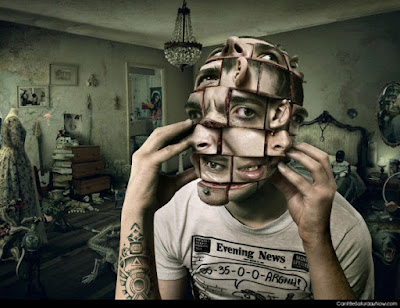
My group decided that it would be more effective if we had research on schizophrenia before we had the role of the main character played. This was important to us because we didn't want to offend our audience by playing the role in an unsympathetic way and we also wanted to raise awareness for this mental illness. After doing some research I discovered that There are five types of symptoms characteristic of schizophrenia: delusions, hallucinations, disorganized speech, disorganized behavior, and the so-called “negative” symptoms. However, the symptoms of schizophrenia vary dramatically from person to person, both in pattern and severity.We decided to focus on the delusions aspect of our film. Highlighting the fact that our main character was intact hallucinating and because of this believed someone was following her. I did some research on the following page; https://www.livingwithschizophreniauk.org/advice-sheets/schizophrenia-and-dangerous-behaviour/
-In an ideal world the patient would be interviewed by the doctor and would describe their experiences fully and in detail and the doctor would be able to make a diagnosis there and then. However, reality is often very different. Sometimes if the patient is suffering from paranoid thoughts they may be suspicious of the doctor or they may be under great pressure from their psychotic thoughts to cover things up rather than tell the doctor everything. This is not their fault it is simply another cruel feature of this illness.
By Naomi
Monday, 21 November 2016
The storyboard for our opening scene
The start of the opening will begin with the credits shown on a blank, black screen and then after a few seconds of the main production title credits the rest of the credits will be over a moving image as the opening fully begins. The first moving image will be of an alarm clock going off which will instantly create an urgent tone to the thriller. The camera then follows the girls personal things that give the audience an indication of the girls personality before seeing the girl. Items such as pills to show her mental issues, lipgloss- to show her femininity and unfinished bar of chocolate could possibly indicate she is a teenager and has less control of her diet. The camera will then focus on her diary and focus on the words ' i saw him ' and the book is closed by her.
The Camera then focuses on the girl and her eyes open wide and dramatically.and the alarm goes off again. The location then changes into the girl at her sink and she throws the remainder of her pills down the sink, showing she isn't helping her illness.
The shots of her show she is very alone so the scenes are often quite empty and there isn't much going on. Then the camera will focus on the door of her opening and on the other side leaving and shutting it. In her notes it will shows that she has an appointment at a particular time. On her way to the doctors she sees the man and looks back then looks forward then looks forward again and isnt there. she then waits for the bus and sees him once again. Close up of the girl with a fearful face as this man is appearing out of nowhere.
On her way back from leaving the doctors the man is staring at her behind a pillar but she doesn't see him and then sees the man in a crowd and he is focussed on or he walks past her directly and bumps into her but when she looks up he is not there.
When she gets home throws her pills on the bed or something like that and goes to the bathroom with her phone. She is looking in the mirror at herself and receives a text she looks at the photo message and it is of her at that exact moment. Close up of a confused, scared face and she looks back down at the photo again and when she looks back up again the man is standing right behind her.
Kaeja and Naomi
RISK ASSESSMENT
(written by Sophie)
There are many risks we will come across when traveling to and from our locations, and even when filming. Traffic in London is a huge risk as if we are not careful there is a chance of being hit by oncoming traffic; to prevent any risk of this we will continue to be street smart and remember to be aware of our surroundings like we do usually.Another risk we may come across is losing equipment or equipment being stolen. As we will be carrying a lot of expensive equipment, we may become a target for theft. To prevent any kind of theft or loss we will make sure we be aware of the people around us and make sure we are in a public place at all times surrounded by people. We will make sure to keep the equipment with us at all times in the bag when not being used, this will prevent people knowing what we have with us.
Another limitation we may come across is the weather; this will play a huge part in the filming that will take place. We cannot film outside when it is raining due to the damage of the equipment. Also it may be a hazard for us as there is a possibility we may fall hurting ourselves or people around us. Although we cannot prevent the weather, we can look at the forecast the evening before and decide what to film and when is the best time to do that.
A risk may be annoyance to the public. If we film people who may not want to be filmed or in the shot this may cause chaos to the individual and the public as a whole. To prevent this we will ask consent for each person present in the film and also ask for permission if filming in a private location. We will try and stay out of the publics way by choosing locations we can film from effectively without disturbance.
Thursday, 17 November 2016
TYPOGRAPHY
(Written by Sophie)
THE SHINING - STANLEY KUBRICK (1980)
The title for 'The Shining' is very eye catching yet also minimalist; this is created by the use of white typography against a black background emphasising the title. The white used connotes 'purity' and 'cleanliness' - however referencing to the film, we know it is far from pure. The picture underneath helps to contradict this; allowing us to identify the colour was used for eye catching purposes only.
DONNIE DARKO - RICHARD KELLY (2001)
The title for 'Donnie Darko' is very effective yet still quite minimalistic. The white against the black background is once again bold and eye catching for the audience - drawing us in. The fact that there is an almost blurred effect on the title may be parallel to what the film entails, as we are aware its a psychological thriller.
TITLE CREDITS
For our title credits, we will use a serif font as it creates a sense of formality within the film which is parallel to our target audience age range. We will make the titles bold not by using a heavy font (as we feel that may not entwine with our genre), but by having coloured typography against a black background - as seen in many psychological thrillers, therefore we will be following the codes and conventions of our chosen genre.
Here are some fonts we are considering using (chosen from dafont.com) :



Our title credits will appear on a black background and seamlessly move into our first scene - very similar as they do in 'Memento'. This will allow the audience to focus on the credits and then be bought into the scene without disturbance.
1) SIGNPOST
2) SIGNPOST PICTURES AND UNDERWORLD PRODUCTIONS
3) UNBALANCE
4) KATIE HOMES
5) SKY ADAMS
6) ZEKE WREN
7) LAUREN MURPHY
8) LEVI GRIMES
9) EVIE STONEMAN
10) CASTING BY CHERIE MOORE
11) MUSIC BY MARCUS LEAN
12) MUSIC SUPERVISOR DANNY FOREMAN
13) EDITOR REMI MICHAEL
14) DIRECTOR OF PHOTOGRAPHY ELIZA ZIASI
15) PRODUCED BY NICHOLAS JACOBS SMITH
Sound design
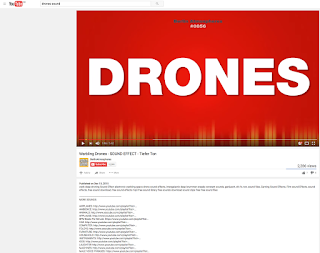
Non diegetic sound such as mood music will be very important in our piece.
This video from youtube has the perfect background sound for our piece as it creates such a deeply tense atmosphere and tone and adds to the conventions of our genre. Above this sound we will layer more audios to further present the thriller and the main parts we want the audience to recognise. The video is legal to use as in the description it says download for free etc so we don't have to worry about copyright laws for this sound. To add more tension at specific parts we could have this sound very low in the background then possibly raise the sound at more dramatic parts.
The sound in this video also set a great tone for a thriller but i feel as this can be the background music that rises at tense parts for example when she sees the man. I think the first song in the video is very sinister and fits perfectly. This video is also fine to use and legal as stated in the description below it says you are able to download.
As well as this i would like to add minor sound effects like a heart pumping etc to add suspension and a sense of urgency.
At the start of the credits there will be an image of a alarm clock therefore we should have the sound synchronised with it in the ticking. There will also be more non diegetic sounds such like trains going, cars driving, breathing, footsteps etc.
kaeja
Audience Detail
Audience detail
In our research we discovered that younger people tend to watch thrillers more, as the main age group for the films we looked into were 25-35. Therefore are target audience will be for around people of this age, we push this by adding a more mature thriller idea by adding a psychological aspect to it so it will keep the mature brains of our target audience activated yet still involved heavily with the sinister element. However this film genre has proven to be extremely popular for teens as well this is also shown when we conducted the public questionnaires and of general knowledge of being a teenager. We expect both genders to be interested in this twisted plot and we intend to keep the audience drawn into the film by the film name ' Unbalance ' as this indicates a question and curiosity about the film as to why is it a 'thriller' would be named unbalanced. It also gives a key indication of what the film is about because the term unbalance emphasises there isn't something quite right. We intend to create a lot of suspension and tension in the opening of the film which will make the audience intrigued to watch on. The film we are making is going to be independent because it is more subjective and risky, as well as it having a smaller production and lower budget above this the actors will be unknown. This is quite essential as it adds to the mysterious, gritty, realistic side to the film that we want to create.
kaeja
Friday, 11 November 2016
SOUND ANALYSIS OF 'DONNIE DARKO'
written by naomi
Here is a Camtasia I have made with annotations based on the type of sound used within the film.
Donnie Darko is very similar to our film idea because it is also a psychological thriller and also attracts the same audience type we intend on aiming our film at ( 25 - 31 years). In the opening of the title sequence there is diegetic sounds of thunder and rain this has indications to darkness and evil as a thunderstorm is commonly quite a thrilling and daunting. After this there is a seamless transitions into birds chirping, and the wind howling this gives us a sense of a new day or start and suggests that it is the morning. The next transition leads us into a soundtrack called Echo and the Bunnymen's 'The Killing Moon'. This song helps contribute to the calm tone set in the atmosphere. The beats begins to pick up when Donnie goes faster on the bike - making the music parallel to the on screen setting.
written by naomi
Here is a Camtasia I have made with annotations based on the type of sound used within the film.
Donnie Darko is very similar to our film idea because it is also a psychological thriller and also attracts the same audience type we intend on aiming our film at ( 25 - 31 years). In the opening of the title sequence there is diegetic sounds of thunder and rain this has indications to darkness and evil as a thunderstorm is commonly quite a thrilling and daunting. After this there is a seamless transitions into birds chirping, and the wind howling this gives us a sense of a new day or start and suggests that it is the morning. The next transition leads us into a soundtrack called Echo and the Bunnymen's 'The Killing Moon'. This song helps contribute to the calm tone set in the atmosphere. The beats begins to pick up when Donnie goes faster on the bike - making the music parallel to the on screen setting.
GENRE CONVENTIONS IN FILM OPENINIGS
Here are screenshots of a power point slide I uploaded on linkin.

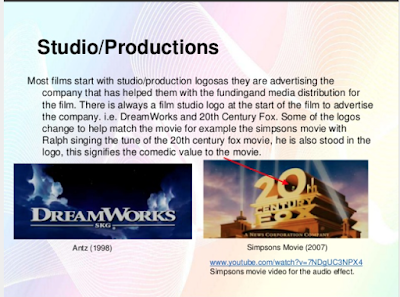
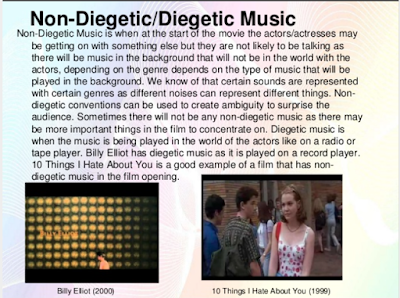
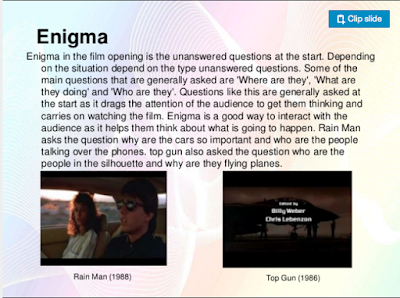
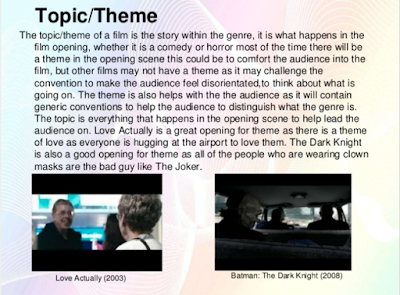
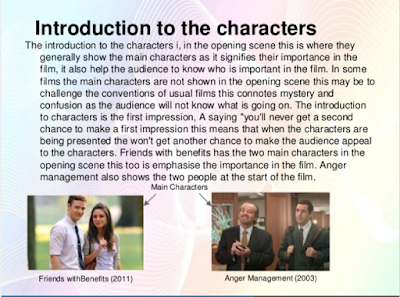

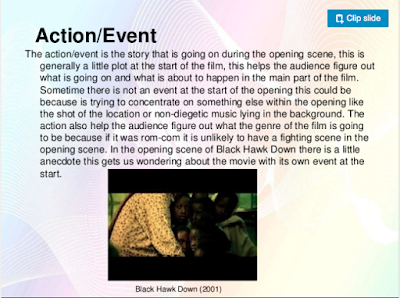
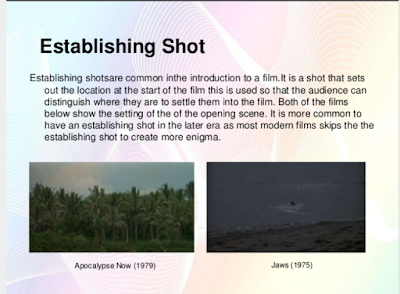
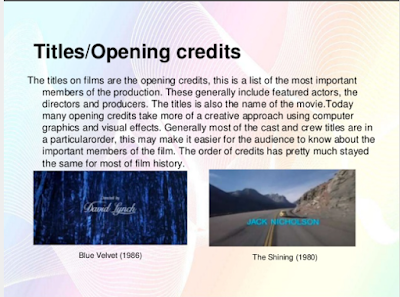
Subscribe to:
Comments (Atom)



































